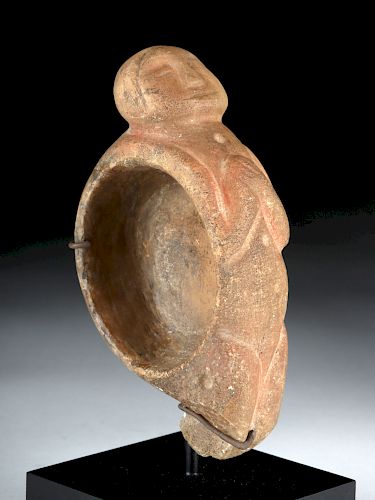Prehistoric Peruvian Alabaster Mortar w/ Human Form
Lot 5d
About Seller
Artemis Fine Arts
686 S Taylor Ave, Ste 106
Louisville, CO 80027
United States
Selling antiquities, ancient and ethnographic art online since 1993, Artemis Gallery specializes in Classical Antiquities (Egyptian, Greek, Roman, Near Eastern), Asian, Pre-Columbian, African / Tribal / Oceanographic art. Our extensive inventory includes pottery, stone, metal, wood, glass and textil...Read more
Estimate:
$4,000 - $5,500
Absentee vs Live bid
Two ways to bid:
- Leave a max absentee bid and the platform will bid on your behalf up to your maximum bid during the live auction.
- Bid live during the auction and your bids will be submitted real-time to the auctioneer.
Bid Increments
| Price | Bid Increment |
|---|---|
| $0 | $25 |
| $300 | $50 |
| $1,000 | $100 |
| $2,000 | $250 |
| $5,000 | $500 |
| $10,000 | $1,000 |
| $20,000 | $2,500 |
| $50,000 | $5,000 |
| $100,000 | $10,000 |
| $200,000 | $20,000 |
About Auction
By Artemis Fine Arts
May 10, 2018
Set Reminder
2018-05-10 10:00:00
2018-05-10 10:00:00
America/New_York
Bidsquare
Bidsquare : Fine Ethnographic / Asian / Ancient Art
https://www.bidsquare.com/auctions/artemis-gallery/fine-ethnographic-asian-ancient-art-3213
Featuring antiquities from around the world including Pre-Columbian, Tribal, Classical, Asian, so much more! Artemis Fine Arts info@artemisfinearts.com
Featuring antiquities from around the world including Pre-Columbian, Tribal, Classical, Asian, so much more! Artemis Fine Arts info@artemisfinearts.com
- Lot Description
Pre-Columbian, north coast of Peru, prehistoric period, ca. 2000 to 1000 BCE. A fascinating and incredibly rare ancient object, a disc-shaped alabaster mortar with an anthropomorphic figure whose body arches backward around one side of the bowl. The figure has a wide, expressive face, shown with closed eyes and mouth, as if in a hallucinogenic trance or dead. His or her hands are clasped over the chest, the legs held close together, and the body marked with two shallow drilled depressions, one above the hands and one below. The bowl itself is smoothed, with straight walls. The stone has a rich, buttery glow, with paler bands of opaque white visible on its base. Size: 5.1" W x 1.1" H (13 cm x 2.8 cm); 6.85" H (17.4 cm) on included custom stand.
This mortar was made to grind materials for the ritual ingestion of hallucinogenic drugs, an important religious activity in ancient Peruvian cultures. Hallucinogenic drugs were used by shamans to enter a spiritual state where they could communicate with animals and the spirit world. Alabaster mortars with figural carving are also known from the Chavin, who lived from ca. 900 to 200 BCE, connecting this piece to the material culture that came after it and emphasizing the continuity of religious tradition.
Provenance: private Hawaii, USA collection; ex-Arte Primitivo Gallery, New York, New York, USA
All items legal to buy/sell under U.S. Statute covering cultural patrimony Code 2600, CHAPTER 14, and are guaranteed to be as described or your money back.
A Certificate of Authenticity will accompany all winning bids.
We ship worldwide and handle all shipping in-house for your convenience.
#131926Rich patina has developed on the surface commensurate with age and handling, with deeply embedded encrustation over much of the surface. Repaired from two pieces, with overpainting on the much smaller of the two pieces. Lower legs of the human figure are lost. Signs of use on the interior.Condition
- Shipping Info
-
All shipping is handled in-house for your convenience. Your invoice from Artemis Gallery will include shipping calculation instructions. If in doubt, please inquire BEFORE bidding for estimated shipping costs for individual items.
-
- Buyer's Premium



 EUR
EUR CAD
CAD AUD
AUD GBP
GBP MXN
MXN HKD
HKD CNY
CNY MYR
MYR SEK
SEK SGD
SGD CHF
CHF THB
THB















